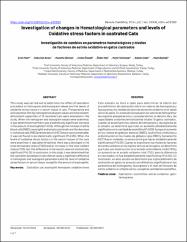Investigation of changes in Hematological parameters and levels of Oxidative stress factors in castrated Cats

View/
Access
info:eu-repo/semantics/openAccessAttribution-NonCommercial-ShareAlike 3.0 United Stateshttp://creativecommons.org/licenses/by-nc-sa/3.0/us/Date
2023Author
Polat, ErenAcısu, Tutku Can
Sönmez, Mustafa
Ünsaldı, Emine
Otlu, Önder
Tanrısever, Murat
Çakır, Aslıhan
Baykalır, Yasin
Metadata
Show full item recordAbstract
This study was carried out to determine the effect of castration
procedure on hemogram and leukogram values and the levels of
oxidative stress factors in serum tissue in cats. Preoperative and
postoperative 10th day hemogram/leukogram values and total oxidant/
antioxidant capacities of 19 castrated cats were evaluated in the
study. When the hemogram and leukogram values were examined,
it was determined that there was a statistically significant increase
in the amount of eosinophils (P<0.05). Although the increase in white
blood cells (WBC), neutrophil and lymphocyte levels and the decrease
in red blood cells (RBC) and hematocrit (HCT) levels were remarkable,
it was not found to be statistically significant (P>0.05). When the
levels of oxidative stress factors in the serum tissues of the cats
were examined, it was determined that there was a decrease in the
total antioxidant status (TAS) and an increase in the total oxidant
status (TOS), but the difference in the results was not statistically
significant (P>0.05). In conclusion, in this study, it was determined that
the castration procedure in cats did not cause a significant difference
in hemogram and leukogram parameters and the level of oxidative
stress factors in serum tissue, except for the amount of eosinophils. Este estudio se llevó a cabo para determinar el efecto del
procedimiento de castración sobre los valores de hemograma y
leucograma y los niveles de factores de estrés oxidativo en el tejido
sérico de gatos. En el estudio se evaluaron los valores de hemograma/
leucograma preoperatorios y posoperatorios al décimo día y las
capacidades oxidantes/antioxidantes totales 19 gatos castrados.
Cuando se examinaron los valores de hemograma y leucograma en
el estudio, se determinó que hubo un aumento estadísticamente
significativo en la cantidad de eosinófilos (P<0,05). Aunque el aumento
en los niveles de glóbulos blancos (WBC), neutrófilos y linfocitos y
la disminución en los niveles de glóbulos rojos (RBC) y hematocrito
(HCT) fueron notables, no se encontró que fueran estadísticamente
significativos (P>0,05). Cuando se examinaron los niveles de factores
de estrés oxidativo en los tejidos séricos de los gatos, se determinó
que hubo una disminución en el estado antioxidante total (TAS) y
un aumento en el estado oxidante total (TOS), pero la diferencia
en resultados no fue estadísticamente significativa (P<0,05). En
conclusión, en este estudio se determinó que el procedimiento de
castración en gatos no provocó una diferencia significativa en los
parámetros del hemograma, leucograma y el nivel de factores de
estrés oxidativo en el tejido sérico, excepto la cantidad de eosinófilos.
Source
Revista Cientifica de la Facultad de VeterinariaVolume
33Issue
2Collections
The following license files are associated with this item:


















